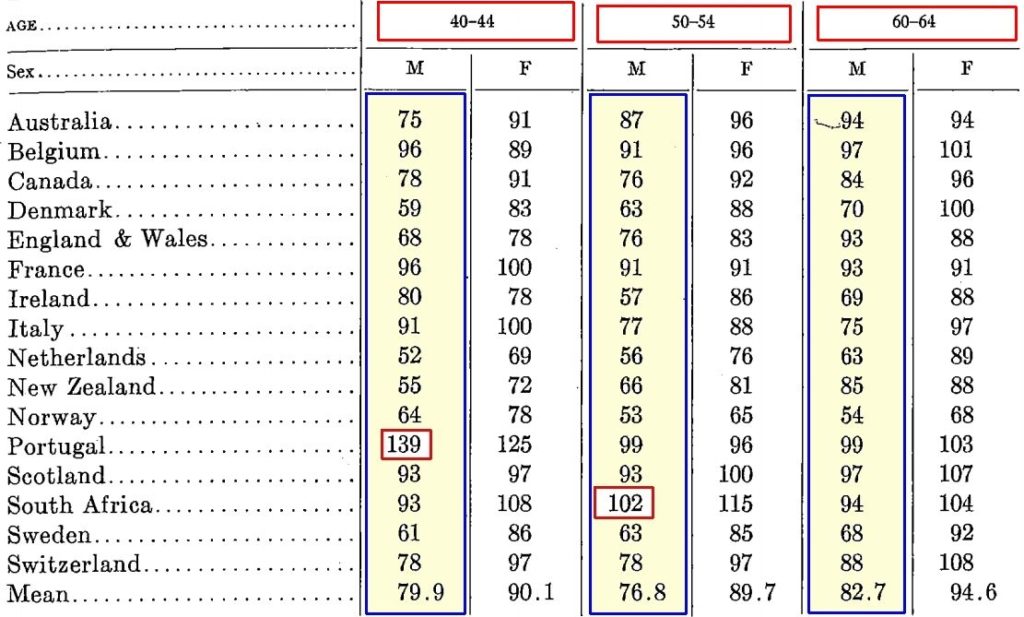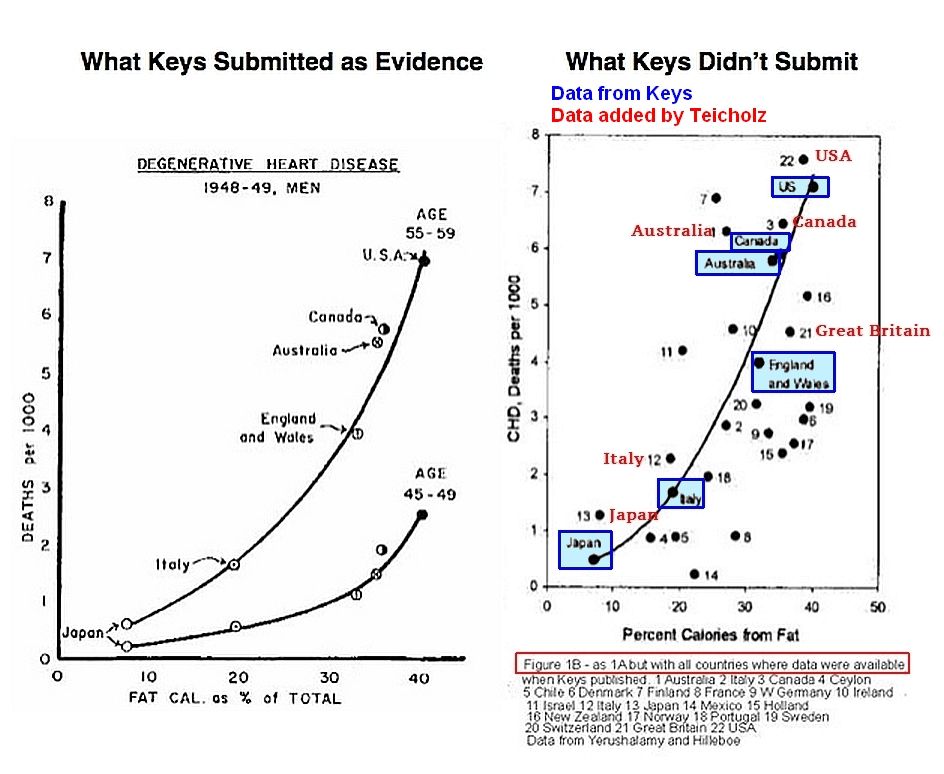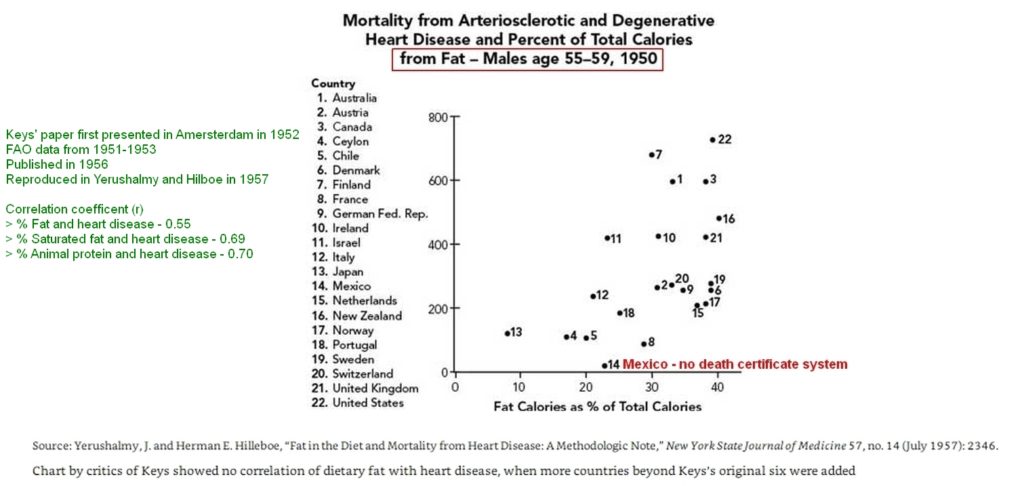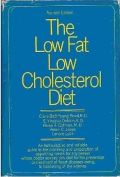Ancel Keys did not manipulate his data
Popular commentators frequently accuse Keys of manipulating data in his 1953 paper, Atherosclerosis, A Problem in Newer Public Health. 1
This study is popularly referred as the “Six-Countries Study”. A number of popular commentators think this is the Seven Countries Study — they count England and Wales as two countries.
This paper was presented in Amsterdam in 1952 and in January 1953 in New York.
On page 4 of this paper, Keys lists 16 countries (which includes France, The Netherlands, Switzerland, and Sweden) and compared their all-cause death rates to the United States. United States compared unfavourably to all countries and Keys believed that what was possible for other countries “should be possible for Americans.” The mortality data was for the years 1947– 1949.
The only countries that have a higher all-cause mortality rate for males are South Africa for 50-54 years old and Portugal for 40-44 year old which have mortality rates of 102% and 139% of the US mortality rate respectively. The increase in Portugal’s mortality rate is attributed to tuberculosis and violence.

On page 17 of this 22-page paper, Keys graphed the mortality rate for degenerative heart disease and fat intake for six countries that he stated had “fully comparable dietary and vital statistics data.” The food data was obtained from FAO for the year 1949.
This graph causes a great deal of consternation in the popular press. The claim is made that Keys “cherry-picked” his data, which is stating that he was dishonest.
Yerushalmy and Hilleboe criticized this paper in the publication Fat in the Diet and Mortality from Heart Disease, 2 claiming that Keys only choose 6 countries (Japan, Italy, England & Wales, Australia, Canada, U.S.) that supported his hypothesis instead of using the World Health Organization data from the 22 countries that was available. The data for the 22 countries that Yerushalmy and Hilleboe listed were for the years 1951-1953, a period which is after the publication of Keys’s paper.
Even if data from all the 22 countries are included, it still shows:
- positive correlations between heart disease and total calories consumed, fat consumption, animal fat consumption, and animal protein consumption, and
- negative correlations with heart disease and carbohydrate consumption, vegetable protein consumption, and vegetable fat consumption.
This observation is clearly stated in Yerushalmy and Hilleboe’s paper. Yerushalmy and Hilleboe were criticising the methodology and the classifications and sub-classifications of heart disease that were used. They were not criticising the lack of correlation.
Using the data supplied by Yerushalmy and Hilleboe for all of the 22 countries, it shows the following Pearson’s correlation coefficients with category B-26 of heart disease. Yerushalmy and Hilleboe used rank correlations – not linear correlations.
- % fat in diet and heart disease – 55%
- % saturated fat in diet and heart disease mortality – 69%
- % animal protein in diet and heart disease mortality – 70%
As a generalization, 90% indicates a very strong correlation, 70-90% a strong correlation and 50-70% a moderate correlation. The claim that there is no correlation (even with all the countries included) is simply false.
Taubes, Teicholz and other popular commentators ignore the fact that Yerushalmy and Hilleboe found the greatest correlation with the percentage of animal protein and heart disease. Once again, that is simply being dishonest. (Note the difference is insignificant – and saturated fat and animal protein are often found in the same food.)
In the book The Big Fat Surprise: why butter, meat, and cheese belong in a healthy diet, Nina Teicholz claims that, 3
Keys was opposed to dietary guidelines. He advocated “our” version of the Mediterranean Diet that was based on the diets of Greece, southern Italy and the Mediterranean regions of Spain and France in the 1960s.
Below are extracts from Teicholz’s book as she tries to justify her argument that Keys manipulated his results. The data that Teicholz has added is shown in red text. It is clear that it is from a completely different set of data to that supplied by Keys. Teicholz has added data for Great Britain for the years 1951-1953 whilst Keys used data for England and Wales for the year 1949 supplied by the Food and Agriculture Organization of the United Nations. The 22 countries that is frequently cited comes from Yerushalmy and Hilleboe.
Henry Blackburn, Keys’s long-time colleague in Minnesota singles out Teicholz for a special mention.
If you go back to the original Food and Agriculture Organization document for the year 1949, you will discover that there were actually 36 countries available. Perhaps we should be asking why Yerushalmy and Hilleboe only included 22 countries. No – not really, it is irrelevant.

Teicholz has changed the date in the heading from Males aged 50-59, 1951-1953 to 1950 so it fits with her chronology of Keys’s deception. That can be only described as being dishonest. Clearly this data was not available to Keys as he first presented his talk in Amsterdam in 1952.
The Six-Countries Study was a minor discussion paper that was ignored until Gary Taubes discovered it to criticise Keys in the book, Good Calories, Bad Calories in 2007. 7
A common accusation regarding Keys is that he made his claims without the benefit of studies. There are numerous studies both before and after this paper performed by Keys and other researchers.
Some examples are listed below.
-
- Cornelius de Langen worked as a doctor in the Dutch East Indies from 1916-1922. He linked diet, serum cholesterol and heart disease by comparing diets of native Javanese and Europeans. He also noted low cholesterol content of bile and the rarity of gallstone in Javanese. He performed possibly the first intervention trial relating to diet and serum cholesterol. Five Javanese men were fed a diet rich in eggs, butter and meat for three months. Their mean serum cholesterol rose 30% from 3.3 mmol/L (128 mg/dL). 8
- Lester Morrison in 1946 also linked diet, cholesterol and heart disease before Keys. His study consisted of one hundred people, mostly men. Every second person was assigned to a low-fat, low-cholesterol diet. The others were told to maintain their usual diet. By the end of twelve years, 19 of the fifty patients treated with the diet survived. All of the fifty control patients had died by the twelfth year.
- Dr John Gofman,
 a nuclear physicist, was a leading pioneer researcher in the field of lipoproteins who was familiar with Anitschkow’s work. His work showed that serum cholesterol and low-density lipoproteins were both indicators of coronary heart disease risk. This work and other evidence convinced Gofman that blood cholesterol, and the dietary determinants of blood cholesterol, were important in atherosclerosis. His wife, Dr Helen Gofman (a medical doctor) co-authored a low-fat, low-cholesterol diet book that was published in 1951—prior to Keys’s 1953 paper. John Gofman wrote the preface for the book. 9
a nuclear physicist, was a leading pioneer researcher in the field of lipoproteins who was familiar with Anitschkow’s work. His work showed that serum cholesterol and low-density lipoproteins were both indicators of coronary heart disease risk. This work and other evidence convinced Gofman that blood cholesterol, and the dietary determinants of blood cholesterol, were important in atherosclerosis. His wife, Dr Helen Gofman (a medical doctor) co-authored a low-fat, low-cholesterol diet book that was published in 1951—prior to Keys’s 1953 paper. John Gofman wrote the preface for the book. 9 - Ancel Keys, in 1947-48, commenced a study of 281 Minnesota business and professional men, then aged 45 to 55 and clinically “healthy.” The Minnesota Business and Professional Men study showed that, “the incidence of coronary heart disease tended to be higher among men above the median at first examination in relative weight, body fatness, systolic and diastolic blood pressure, and serum cholesterol concentration but these segregations were not statistically significant except with serum cholesterol”.
In 1951, Keys was working at Oxford when the Food and Agriculture Organization asked him to chair their first conference on nutrition in Rome. Keys states, “The conferees talked only about nutritional deficiencies”. When he asked about the new epidemic of coronary heart disease, Gino Bergami, Professor of Physiology at the University of Naples, said “coronary heart disease was no problem in Naples”.
In 1952, Keys and his wife Margaret visited Naples. Margaret measured serum cholesterol concentrations and found them to be very low except among members of the Rotary Club. Heart attacks were rare except amongst the rich whose diet included daily servings of meat. He obtained similar results in studies in Madrid.
Keys and his wife Margaret wrote three books extolling the virtues of the Mediterranean diet: Eat Well and Stay Well (1959), The Benevolent Bean (1967); and How to eat well and stay well the Mediterranean Way (1975). 10 11 12
Popular commentators frequently confuse the “Six-Countries Study” with the Seven Countries Study.
Below are two commentaries by self-styled health experts.
Jonathan Bailor Self-described “Internationally Recognized Wellness Expert”
Georgia Ede, MD, Psychiatrist – Speaker at Physicians for Ancestral Health Symposium 2016
Both are completely confused.
Ede states that the Seven Countries Study was published in 1970 but claims that when Yerushalmy and Hilleboe examined the data that they found no correlation between fat and heart disease. Yerushalmy and Hilleboe found correlation with “% fat in diet and heart disease“, “% saturated fat in diet and heart disease mortality” and an even greater correlation with “% animal protein in diet and heart disease mortality“.
Yerushalmy and Hilleboe’s paper was published in 1957. The data that Yerushalmy and Hilleboe refers to was not available until 1956 – a long time after Keys published his “minor discussion paper” in 1952 and 1953.
The “Internationally Recognized Wellness Expert” makes similar nonsensical claims, being confused with dates and the studies that he has “examined in detail“.
A biography of Ancel and Margaret Keys, Genius and Partnership Ancel and Margaret Keys and the Discovery of The Mediterranean Diet has been written by Joseph Dixon. 13
Related articles
Last updated on Saturday 28 January 2023 at 03:13 by administrators
Footnotes
- Keys, A. (1953) Atherosclerosis: a problem in newer public health. Journal of Mt Sinai Hospital. July-Aug; 20 (2), 118–139.
- Yerushalmy, J. & Hilleboe, H. E. (1957) Fat in the Diet and Mortality from Heart Disease. New York State Journal of Medicine. 57 (14), 2343–2354.
- Teicholz, N. (2014) The Big Fat Surprise: why butter, meat, and cheese belong in a healthy diet – Revised. Revised Edition. Scribe.
- Keys, Ancel, and Margaret Keys. 1975. How to Eat Well and Stay Well the Mediterranean Way. Doubleday, Garden City, NY. p4
- Keys, Ancel. (1995) Mediterranean Diet and Public Health : Personal Reflections. American Journal of Clinical Nutrition 61 (6):1321S–1323S.
- Blackburn, H. (2014) In defense of U research: The Ancel Keys legacy – Star Tribune (Accessed 2 February 2018).
- Taubes, G. (2007) Good Calories, Bad Calories. New York: Random House.
- Truswell, A. S. (2010) Cholesterol and Beyond: The Research on Diet and Coronary Heart Disease 1900-2000. Springer Netherlands.
- Dobbin, E. V. et al. (1951) The Low-Fat, Low-Cholesterol Diet. Doubleday, Garden City, NY.
- Keys, A. & Keys, M. (1959) Eat Well and Stay Well. Doubleday, Garden City, NY.
- Keys, A. & Keys, M. (1967) The Benevolent Bean. New York: Doubleday, Garden City, NY.
- Keys, A. & Keys, M. (1975) How to eat well and stay well the Mediterranean way. Doubleday, Garden City, NY.
- Dixon, J. L. (2015) Genius and Partnership Ancel and Margaret Keys and the Discovery of The Mediterranean Diet. New Brunswick, NJ: Joseph L. Dixon Publishing.








